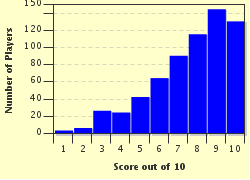Quiz Answer Key and Fun Facts
1. A disease which is the subject of an eradication programme is Hansen's disease. By what name is it often known?
2. Tuberculosis was a common cause of death in nineteenth century England. By what name was it known at that time?
3. Rubella is a disease which has been substantially reduced following the introduction of vaccination programmes. Its effects are most serious for which group of people?
4. Diphtheria is a disease which affects which part of the human body?
5. Up to the end of the twentieth century, only one disease had been declared eradicated by the World Health Organisation, in 1979. What is it?
6. The illness commonly known as whooping cough is known by which of these scientific names?
7. Creutzfeldt-Jakob disease was first identified by two scientists who were working in which country?
8. Poliomyelitis was a major cause of paralysis, especially in young people, during the early part of the twentieth century. A vaccine was made available in 1955 due to the work of which man?
9. The MMR vaccine is routinely given to babies in many countries of the world. The first M stands for Measles, but what disease is the second M?
10. The influenza pandemic which began in 1918 was named after which European country?
Source: Author
rossian
This quiz was reviewed by FunTrivia editor
CellarDoor before going online.
Any errors found in FunTrivia content are routinely corrected through our feedback system.

